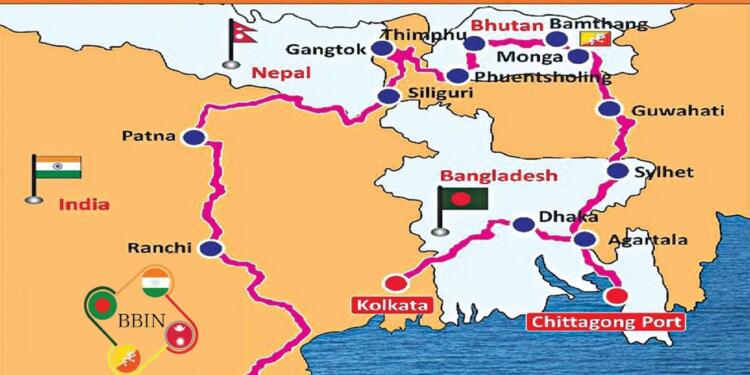On Tuesday, India, Bangladesh and Nepal reached an important milestone. The three countries finalised an enabling memorandum of understanding (MoU) for implementation of the Bangladesh-Bhutan-India-Nepal (BBIN) Motor Vehicles Agreement (MVA).
Also Read: India’s $500 million line of credit to Bangladesh cancels Turkey and China’s grip on Dhaka
So, what is the BBIN MVA and how does it counter the BRI? Let’s find out.
BBIN connectivity initiative explained
The BBIN Motor Vehicles Agreement (MVA) came into the picture in 2015, after the South Asian Association for Regional Cooperation (SAARC) failed to agree on a regional Motor Vehicles agreement.
The MVA was signed by the BBIN countries in 2015 with the object of facilitating the unrestricted movement of cargo, persons, and personal vehicles between the four South Asian countries.
The idea behind the MVA is to eliminate the cross-border restriction on the movement of goods and persons in the region. It is supposed to allow vehicles carrying trade and transit cargo to move freely inside the four countries without trans-shipment to local trucks at border crossings.
BBIN initiative to realise full trade potential
The enabling MoU was signed during a meeting held at Delhi on March 7-8. Bhutan, which had temporarily opted out of the MVA in 2017, participated in the meeting as an observer. As per the Ministry of External Affairs, the MoU was finalised “pending ratification of the MVA by Bhutan”.
During the meeting, the countries emphasized the importance of operationalising the MVA to “enable seamless movement between them for facilitating trade and people-to-people contact”.
The conclusion of passenger and cargo protocols to operationalise the BBIN MVA will also help the four countries realise their full trade potential by improving sub-regional cooperation.
Presently, weak transport integration makes the border crossings in the region a major obstacle in intra-regional trade. Crossing the India-Bangladesh border at Petrapole-Benapole, for example, takes several days. On the other hand, the time to cross international borders handling similar volumes of cargo in other parts of the world is less than six hours.
Most of the regions across the world focus on improving intra-regional trade. Last year, World Bank India Head Junaid Ahmad said that in East Asia, 50 per cent of the trade is between neighbours. “In Africa, over 22 per cent of trade is between neighbours.”
Ahmad added, “In our part of the world, we have numbers that are far below those potential. We need to achieve those potential to give regional growth a major push.” And this is where the BBIN MVA initiative becomes quite relevant.
Countering the Belt and Road Initiative
For India, bringing the BBIN MVA into effect becomes a key tool to counter China’s BRI.
China has been trying to expand its BRI footprint in India’s neighbourhood in South Asia. In fact, both Nepal and Bangladesh joined the BRI in 2017 and 2016 respectively. China has spent billions of dollars in the two countries for building ports, economic corridors and Universities. Beijing wants to debt trap the two countries and challenge India in its own backyard.
This is why the BBIN corridor is crucial for India. Presently, both Nepal and Bangladesh are trying to be careful on the China front. Dhaka was always treading cautiously and the Sher Bahadur Deuba government that came to power in Nepal last year too seems keen to cut dependence on Beijing.
Read more: After realising the true ‘potential’ of Chinese aircraft, Nepal looks all set to dump them
BBIN could serve as an alternative for the two nations. Seamless transport connectivity between India and Bangladesh is expected to enhance Bangladesh’s national income by as much as 17 per cent, while also helping India increase its national income by 8 per cent.
Nepal too will benefit from any such initiative. India accounts for 64 per cent of Nepal’s overall trade. Easier movement of goods and persons between India and Nepal will enhance trade and ramp up the Himalayan country’s national income.
Also, Nepal uses Indian ports for routing its exports and imports to the world at large. A quick movement of goods between India and Nepal can therefore allow Kathmandu to improve its overall trade numbers as well.
If countries in the region can earn more by signing a simple agreement, they won’t have to take the bait of Chinese investments. India can further supplement the BBIN corridor with new road and rail projects that are coming up in the region.
India has thus shown how to tackle the BRI. And the BBIN has emerged as New Delhi’s answer to the BRI.





























